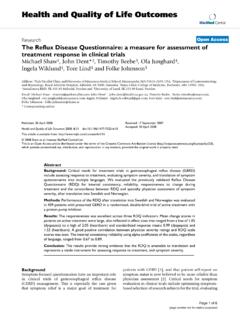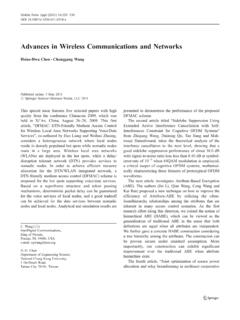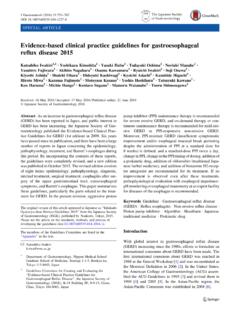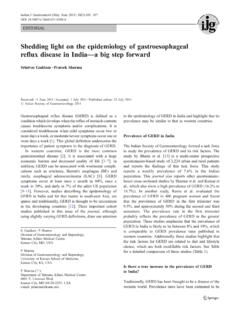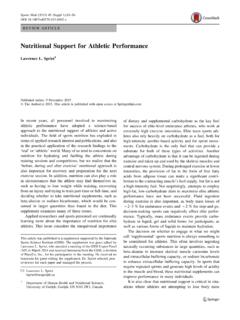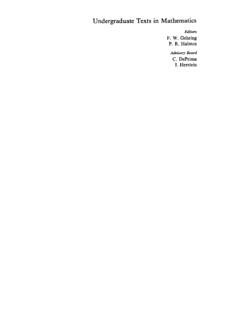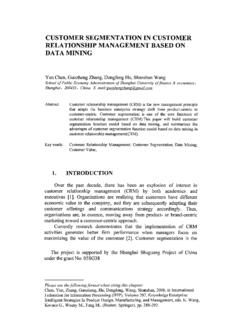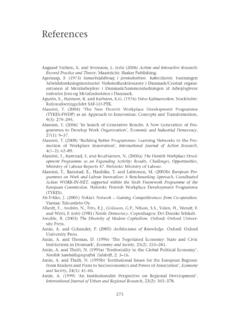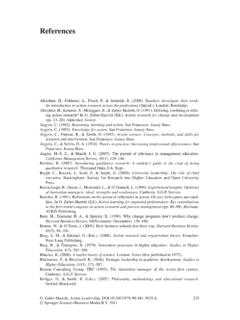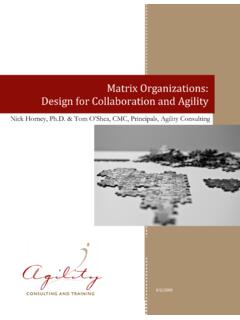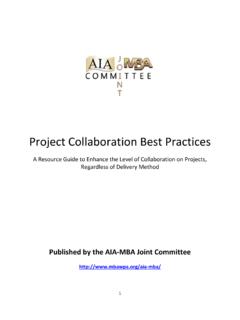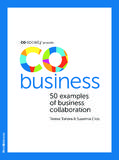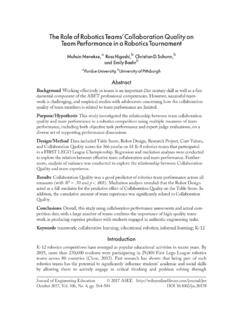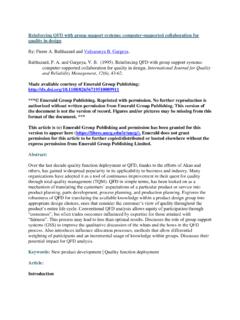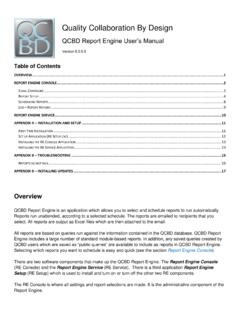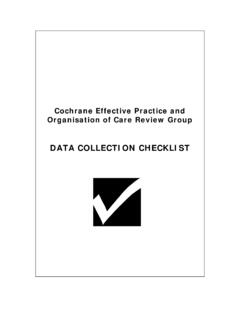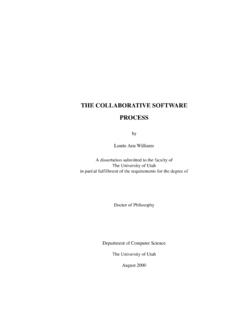Transcription of LNCS 5727 - Assessing the “Quality of Collaboration” in ...
1 T. Gross et al. (Eds.): INTERACT 2009, Part II, LNCS 5727, pp. 157 160, 2009. IFIP International Federation for Information Processing 2009 Assessing the quality of collaboration in Technology-Mediated design Situations with Several Dimensions Jean-Marie Burkhardt1, Fran oise D tienne2,3, Anne-Marie H bert2, and Laurence Perron4 1 Paris Descartes University, Ergonomics Behavior-Interaction Lab. 45 rue des Saints-P res 75270 Paris Cedex 06, France 2 LTCI- UMR 5141 - CNRS - Telecom Paris Tech 46 rue Barrault 75634 Paris Cedex 13, France 3 INRIA-Paris, France 4 France Telecom R&D / Orange Labs, Lannion, France Abstract. Our objective is to measure and compare the quality of collaboration in technology-mediated design activities.
2 Our position is to consider collabora-tion as multidimensional. We present a method to assess quality of collabora-tion composed of seven dimensions concerning communication processes such as grounding, coordination processes, task-related processes, symmetry of indi-vidual contributions as well as motivational processes. Keywords: multi-user interaction /cooperation, collaboration , design , method-ology, cognitive ergonomics, CSCL. 1 Introduction Methods for Assessing the quality of mediated- collaboration are to be as central in user-centred design as the methods used for Assessing the ergonomic quality of inter-face, the usability of UI [1]. In spite of a growing number of methods to evaluate groupware technologies and group work [ 2], no measurement method of this facet of activities in collaborative design situations has been proposed as far as we know.
3 In the close field of Computer-Supported Collaborative Learning (CSCL), the analysis of the process of collaboration is a central topic of research. The Spada rating scheme [3,4] is certainly the most representative of recent effort made in this field to assess nine dimensions of collaboration and its quality . In this paper, we propose an evaluation method to cover these several dimensions of the quality of collaboration in technology-mediated design situations together with explicit qualitative criterion whenever possible. The term quality has two distinct meanings. Firstly, it refers to the essence of an object, , a specific feature of the object. quality in this sense does not suppose any positive or negative value.
4 Sec-ondly, the word quality refers to the good versus bad values of an object s properties, based on a set of (more or less explicit) criteria. quality also implies that norms and references are provided to support the comparison of objects according to 158 Burkhardt et al. measured values. We use the notion of quality to underline that (a) our method focuses on those dimensions of activity related to collaboration quality and (b) that we aim to elicit references (often implicit in the literature) and relevant standards regard-ing collaborative activities. In the next parts, we briefly report on the rationale of this multidimensional approach on the basis of theoretical arguments and of results from empirical studies (see [5] for an extended version).
5 Then, we present our method to assess the quality of collaboration , and report on our current work and perspectives. 2 Assessing quality of collaboration : Multidimensionality and Explicit References Previous work in cognitive ergonomics of design and in CSCL has shown collabora-tion as multidimensional. For example, empirical studies on collaboration in design teams (for a state of the art, see [6]), in various application domains ( , software design , architectural design ), have highlighted the following distinctive collaborative processes most important for successful design : communication processes such as grounding [7], task-related processes ( exchanges of knowledge relevant for the task at hand; argumentation processes), coordination processes, and motivational processes.
6 The latter encompass interpersonal relationship and motivation, which are less covered in studies on design , although this more subjective dimension might affect strongly the actual way of collaboration . Finally, how symmetric are individual contributions through all these dimensions provides a complementary aspect of quality of collaboration . These processes can be taken as a referential of good col-laboration with respect to design . Evidence from studies can be used to set potential referential values regarding collaboration and efficacy. As an illustration, empirical studies of collaborative design ( [8, 9, 10] found that grounding, although time-consuming, was most important to ensure good design : for instance, in [10] when teams bypassed grounding (referred to as analysis ), this led them to premature evaluation of design ideas.)
7 Other studies show that at distance, characteristics of communication media, such as no visibility, or no simultaneity [7], may affect grounding and awareness. As another illustration, recent research on collaboration processes in design [11] considers the balance between the roles of participants ac-cording to communication, group management and task management as a good indi-cator of collaboration . This aspect is similar to the notion of reciprocal interaction [3] and symmetry in the interaction [12] in CSCL. 3 Assessing the quality of collaboration in Technology-Mediated design : Our Method Our method is initially (and thus partly) based on Spada s method [3]. This method shows some limits ( indicators to assess collaboration are underspecified, subjec-tive rating), however its multidimensional characteristic is a good basis to further develop a method to assess the quality of collaboration in technology-mediated de-sign.
8 The method has been modified so as to take into account empirical results on collaborative design . We have also modified the scoring method to improve the Assessing the quality of collaboration in Technology-Mediated design Situations 159 Table 1. Dimensions and indicators of our method Dimensions Definition Indicators 1. Fluidity of collaboration It assesses the management of verbal communication (verbal turns), of actions (tool use) and of attention orientation -Fluidity of verbal turns -Fluidity of tools use (stylet, menu) -Coherency of attention orientation 2. Sustaining mutual understanding It assesses the grounding processes concerning the design artifact (problem, solutions), the designers actions and the state of the Augmented Reality desktop ( activated functions).
9 -Mutual understanding of the state of design problem/solutions -Mutual understanding of the actions in progress and next actions-Mutual understanding of the state of the system (active functions, open documents) 3. Information exchanges for problem solvingIt assesses design ideas pooling, refinement of design ideas and coherency of ideas. -Generation of design ideas (problem, solutions, past cases, constraints) -Refinement of design ideas -Coherency and follow up of ideas 4. Argumentation and reaching consensus It assesses whether or not there is argumentation and decision taken on common consensus. -Criticisms and argumentation -Checking solutions adequacy with design constraints -Common decision taking 5. Task and time management It assesses the planning ( task allocation) and time management.
10 -Work planning -Task division -Distribution and management of tasks interdependencies -Time management 6. Cooperative orientation It assesses the balance of contribution of the actors in design , planning, and in verbal and graphical actions. -Symmetry of verbal contributions -Symmetry of use of graphical tools -Symmetry in task management -Symmetry in design choices 7. Individual task orientation It assesses, for each contributor, its motivation (marks of interest in the collaboration ), implication (actions) and involvement (attention orientation). -Showing up motivation and encouraging others motivation -Constancy of effort put in the task -Attention orientation in relation with the design task assessment procedure[13].
